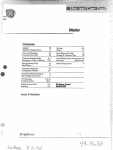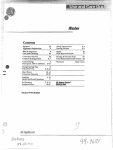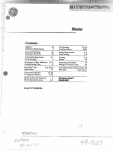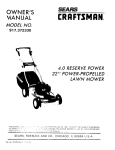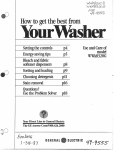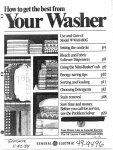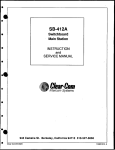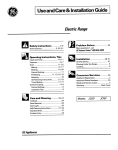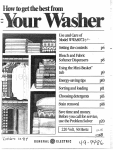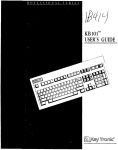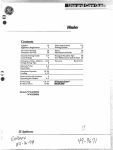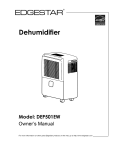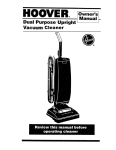Download GE WWA6600M User's Manual
Transcript
—.——
Contents
.4gitator
Appliance Registration
22
2
Pre-Treating
Problem Solver
Care and Cleaning
Consumer Services
22
23
SafetyInstructions
Soak Setting
3,4
5,8
Sorting
Stains
4,9
16
Controls Setting Guide
CycleSettings
6,7
5
Detergents, Other Additives 11-15
Energy-SavingTips
8
Filter-Flo@Pan
Hard Water
4,8, 10,22
14
Limestone Deposits
Loading the Washer
Modeland Serial Numbers
Operating Instructions
Model WWA6600M
Stain RemovalGuide
Storage &Vacation Tips
17
23
User MaintenanceInstructions 22
Warranty
Back Cover
12,22
4, 10
2
4
7,9,15
18-22
GEAnswercenf.r@
8oa82&2@oo
HYOUNeedSetice
It is intended to help you operate
and maintain your new washer
properly.
Keep it handy for answersto your
questions.
If you don’t understandsomething
or need more help, write (include
your phone number)
Consumer Affairs
GE Appliances
Appliance Park
Louisville, KY40225
Ifyoureceived
a
dam%ed
washer...
Immediately contact the dealer
(or builder) that sold you the
washer.
Savetime andmoney.
Beforeyou request service...
check the Problem Solver on
pages 18through 22. It lists causes
of minor operating problems that
you can correct yourself.
writedolvnthemodel
andserial
numbers.
You’llfind them on a label on the
iower left side near the front.
Toobtaina Spanishlanguage
versionof thisbook, call
GE AnswerCenter@
800.626.2000
consumerinformationservice.
Paraobtenerla versi6nen
espafiolde estemanual,
Ilamea
GE Answer Center?
serviciode information
parael consumidor,
tel~fono800.626.2000.
FORYOURSAFEW
1,open
Windowsa
2sDon’ttouch
electrical
switches:
311
Extinguish
any
openflames
4=Immediately
call
yourgasSuppliera
*Don’tturn electric switches
on or otibecause sparks may
ignite the gas.
These numbers arc also on the
Consumer Product Ownership
Registration Card that came with
your washer. Before sending in this
card, picasc write these numbers
here:
Model Number
——.——..
Serial Number
.:i
To obtain service, see the
Consumer Servicespage in the
back of this book.
We’reproud of our service and
wantyou to be pleased. If for some
reason you are not happy with the
service you receive, here are f,hree
stepsto followfor further help.
FIRST, contactthe people who
serviced your appliance. Explain
why you are not pleased. In most
cases, this will solvethe problem.
NEXT, if you are still not pleased,
write all the details-including
your phone number—to:
Manager, Consumer Relations
GE Appliances
Appliance Park
Louisville,Kentucky40225
FINALLY, if your problem is still
not resolved, write:
Major Appliance
Consumer Action Panel
20 North WackerDrive
.*’~:=
Chicago, Illinois 60606
:ez
~T~
.Q ..
Readal~imtructiom
before
lwing thk appliance.
. .—.—.
reduce the risk of
WARNWG–TO
fire,
electricshock, or injury
to
penomwhenwingyourapptiance,
followbasicprmutiom, hclutig
thefoilowing:
~Usethisapplianceonlyforik
intendedpurposeas described in
thisUse and Care Book,
*This washermustbeproperly
imtied andlocatedinaccordmce
withtheInstallationInstructions
beforeitis used.If you did not
receivean InstallationInstructions
sheetwith your washer, youcan
obtainone by contactingthe service
locationnearest you.
–Properly ground to conform
with allgovertingcodesand
ordinances.Followdetailsin
ktillation Instructions.
–Install orstorewhereit Wfllnot
beexposedtotemperaturesbeIow
freezingorexposedtotheweather.
–Connect to a properly rated,
protected and sjzedpower supply
circuit to avoidelectrical overload.
–Connect to adequate plumbing
and drain facilitiesas described in
the 1nstallationInstructions.
* Turnoff water faucets when
the washer is not in use to relieve
pressure on hoses and valves, :]ndto
nlinimize leakage ifa hose or valve
shouidbreakor rupture.
*~hcn disconnectingthis
;]pp~iance
pullbytheplugrather
[banthe cord to avoid damage to the
cord or.junction of cord and plug.
Fy’fake
sure ~hatthe cord is located so
ihat ~1w~~~
not be stepped on. tripped
{)vcrc]rotherwise subjected to
d;iI12:i~C3
or stress.
—.—
,
—
.-
...-.
_.
@Closesupervisionisnecessary
if thisapplianceisusedbyornear
children.Donot8I1owchildren
toplayinside,onorwithtfi
applianceOranydiscarded
appliance.Disposeofdscarded
appliancesandshippingor
packingmaterialsproperly.
BeforeWscardinga washer,or
removingfromserviceyremove
thewasherlid.
~ Keepall laundry aids (suchas
detergents,bleaches,fabricsotiners,
etc.) out of the reach of children,
preferablyinalockedcabinet.Observe
aflwarningson container labelsto
avoidpersonal injury.
@Keep the area around and
underneath your appliancesfree
frorntheaccumulationofcombustible
materials, such as lint, paper, rags,
chemicals, etc.
@
flooraroundyOur
Keep
the
appliancescleananddry toreduce
thepossibilityofslipping.
@Tominimizethepossibility
ofelectricshock,unplugthis
appliancefromthepowersupply
beforeattemptinganymaintenance
or cleaning(excepttheremovaland
cleaningofthelintfilter).
NOTE:TurningtheCycleSelector
knobtoanOFF positiondoesN~
disconnecttheappliancefromtlIe
powersupply.
@~~ not tamper with controls.
oDonotoperatethis appliance
if it is damaged, malfunctioni~]g,
partially disassembled, or has
missing or broken parts, including
a damaged cord oxplug.
QNeverclimbonor standonthe
washertop.
QDo notwashfiberglassarticlesin
yourwasher.Skini~~itationcould
resultfromthe xemainingpayticles
thatmaybe pickedLIpbycloti~ing
duri~gsubseque12”[
washerl!se,
.%.
-4--..---_,
-.w..
.4..
.+-...,.
,! -~..-.
:l([gP):>
[Cojliir!?!cfi’
[Zc:<l
ri-.--,-J—. --.. ..~--:#,”’
ImportantSafetyImtructiom (continu~d)
= The laundry p~ocesscan rtiuce
the flame retardancyof fabrics. To
avoidsuch a result, tie garment
manufacturer’scare instructions
should be followedvery carefilly.
For washer operation
@Do not leave washer lid up
during cycle. This will stop the.
wash and spin action and prevent
completion of the cycle.
SAW TmsE
msTRucTIoNs
HowtoOpemte your clotheswasher
WM~G—To reduce the risk of fire, electric shock, or injury topersons,
read the IMPORTANT SMETY INS~UCTIONS beforeoperatingthisappliance.
sorting
and bading
* Sort clothes carefully by fabric
type, weight, color and amount of
soil according to instructions on
page 9.
~ RemoveFilter-Flo@pan. The
underside of the lid is a good place
to put the pan while 1oadingor
unloading clothes.
@Add measured amount of
detergent. See pages 11through 15
for information on detergents and
other launch-yadditives.
@Load clothes into the wash
l~:]sl{ct
being carefil not to overload.
Clothes shou!dbc below the retaining
rir]g. Sec page 10for more Ioading
i~lfor~]]atiorl.
@Position the Filter-Flo pan on the
agitator. Lint will collect in the pan
for easy removal when the wash is
finished.
N~E: Do not use the Filter-Flo
pan as a wash basket. Do not put
any items to be washed in the
Filter-Flo pan.
~ For information on bleaches and
fabric softeners, see page 15.
@Close the lid. Washer will fill but
not agitate or spin with the lid open.
setting the controls
Use the ControlsSettingGuideon
pages6 and 7 to help you make the
proper selections.
@ Select Water Level.
SMALL: Washer is less than %
full of clothes.
MEDIUM: Between % and % full.
LARGE: Between % and 2Afull.
EXTRA LARGE: Over 2Afull.
@ SelectWash/RinseTemperature.
@ ~sh Cycle SelectorKnob in
and turn clockwiseto your selected
wash setting.
@ PuUCycle Selectorfiob out
to start the-washer.1fyou wish to
change settingafter washer has
started, push CycleSelector Knob
in to stop the washer and reset to
the new position. Settingcan be
changed at any time.
TipstoHelpYou
select settings
Mlar cyeles—
Permanent
Ress cycIes—
soakcycle–
Provideslonger wash time for
mostcottons, linens, work and
playclothes.
For permanent press and delicates.
An extendedcool-downspray rinse
is providedto minimizethe setting
of-wrinkles,
Use with most soakingaids to
loosen embedded soils and stains.
RegularCycles
I
OFF
B@
NORMAL
r’
I
OFF
Regular Cycles
UG
1
)
e
o
Soak Cycle
Soak Crcle
N!lRMAL
s$@
~
~
❑
o
:Ie
c1
~
4
uGNT
I
NORMAL
SOIL
W1l EllOB 10 SIAX1
‘EAW
PUSH TO
NOi!,iAL
SOIL
e
LIGHT
S1OP
whatHappeminEachsetting
(ApprotiafiMnuks)
Regular
I
Spin
Rinse
Spin
TotalTime I
Normal
Soil
Heavy
Permanent Press
Soak
Cycle
Light
I
19
15
6
31/2
31/2
31/’.!
31/2
31/2
31/2
7
35
I
7
31
#
7
22
31/2
1
‘EAV’
wu KtIW70 STMT. WSH roSTOP
SOIL
Selector
Settings
Wash -
m *Q Ow
L
LIGHT
\
cycle
&
7
11
Normal
Light
10
4
21/..
2~/2
31/2
31/2
41/2
I
)
221/2
41/2
I 161/2
I
N~ES:
@Total time includes pauses between each phase of cycle.
e Total time does tzot include water fill time. Filltimes vary depending on household
lt’ater pressure and your selected water level.
.’=-!
Controksetting
Guidefor
differentfabricsandloam
~c,.1.settin,‘--‘--
I
Cottonsand Linens
White/Colorfast
Bright/Noncolorfast
Workclothes,dungarees, etc.
Heavy soil
Averagesoil
RegularCycles
RegularCycles
Hot
Hot or Warm
RegularCycles
Regular Cycles
Hot
Warm
Permanent Press Cycles
Permanent Press Cycles
Normal Setting
Light Setting
Warm
Warm
Permanent Press Cycles
Permanent Press Cycles
Normal Setting
Light Setting
Warm
Permanent Press Cycles
Light Setting
Warm
Permanent Press Cycles
I
I
Permanent Press, Treated Cottons,
Blends with Cottons
Heavy or oily soil
Averageor light soil
Synthetics—Polyester,Nylon,
Acrylic Knits and WovenFabrics
Sturdy
Delicates
Silks, Woois; Blends of Silk
and Wool
Normal Soil Setting
Normal Soil or Light Setting
Hot or Warm
Warm or Cold
I
c-
Normal Soil for small loads; Heavyfor all other loads
1 Normal Soil Setting
i
Rayonand Acetate
Light Setting
1
I
Down-filled garments, if machine
washingis recommended
Warm
Permanent Press Cycles
Normal Setting
Hot
Regular Cycles
Normal Soil or Light Setting, depending on
amount of soil
Warm
Permanent Press Cycles
Light Setting
Warm
Regular Cycles
_&
I
BabyCIothes—Sturdy,such as
Diapers, Nightgowns, Shirts, Pads,
Sheets, Receiving Blankets,
Coveralls
Baby Clothes—Delicate
I
Blankets—Wool,Part-WooI,Cotton
Blankets—Synthetic, Electric
Warm
Regular Cycles
I
Curfains–DO NOT MACHINE
WASHFIBERGLASS
Cl~enillcBedspreads, Robes**
Hot or Warm
1
I Hot or Warm
Slipcovers, Draperies, Bathmats
and Rugs**
1
Denims (cspecia!]y Indigo Blue
,leaIIs)and other fabrics that bleed
Light Setting
I
I
I
Permanent Press Cycles
Light Setting
Light Setting
1
-——
Permanent Press Cycles
Light Setting
Hot or Warm
Regular Cycles
Normal Soil Setting
Cold or Warm
Regular Cycles
Normal Soil Setting
Wdrnl
Permanent Press Cycles
Light Setting
I
Rubber-coated Items, Laminated
Fabrics. Viny], Plastics and
Ar(iclcs with Plastic Trim
aI
Iu
Permanent Press Cycles
Normal Soil or Light Setting, depending on
amount of soil
Bleach
special Instructions
Liquid chlorine type.
Only non-chlorine bleach when needed.
If colorfast is unusually soiled, use hot water. Use maximumdetergent recommendedon
page 13.
White or colorfast, liquid chlorine type.
Non colorfast, only non-chlorine bleach
when needed.
Use maximum detergent recommended in guide on page 13.
Whiteor colorfast, liquid chlorine type.
Noncolorfast, only non-chlorine bleach
whenneeded.
Small loads reduce wrinkling. Use maximum detergent recommended in guide on page 13.
Whiteor colorfast, liquid chlorine type.
Noncolorfast, ody non-chlorine bleach
whenneeded.
If unusually soiled, use hot water. Use maximum detergent recommendedin guide on
page13.Small loads reduce wrinkling.
Washonly if recommended by the garment manufacturer. Followinstructions carefully.
;eldomneeded. If needed, use on]y
on-chIorine bleach.
Washin your washer only if recommended by the garment manufacturer.
10bleach
Washfrequently to fluff up the downand retain the garment’s warmth. Washseparately. Wet
iown gives off an odor which maybe absorbed by other garments. Odor disappears when
;arment is dry. Treat heavily soiled areas with liquid detergent or paste made of water and
;ranular detergent. Close zippers. Wash2 or 3 at a time or add towelsto balance.
3ARMENT MUST BE TUMBLE D~ED.
‘biteor colorfast, liquid chiorine type.
{OUmay prefer to use a mild-type detergent. Do baby clothes separately. Pretreat spots.
tinse diapers, nightgowns,pads and sheets after use. Keep diapers in a coveredpail of cold
vaterand conditioning agent like Borateem brand.
Ily non-chlorine bleach when needed.
I ‘OUmay prefer to use a mild-type detergent. Do hand-knit garments by hand.
‘illwasher, add detergent, allow to dissolve before adding blanket. Do one blanket at a time.
‘retreatheavily soiled spots with liquid detergent.
I bleach
On electric blanket, sew a strong piece of cloth over plug to protect blanket and washer from
damage, Do one blanket at a time. Pretreat heavily soiled spots with liquid detergent.
hitc or colorfast, liquid chlorine type.
I Vacuumout loose dirt before washing.
]ilc or colorfast, liquid cillorinc type.
Iitcor colorfast. liquid chlorine type.
Wash only 2 or 3 rugs or mats at one time. Shake before washing to remove excess dill,
bletich
For new “indigo blue” jeans, wash at least 3 times in very small loads with full water fill.
Jeans need ample room to move to avoid white lines at creases. May discolor plastic washer
parts. Subsequent washings will reduce discolorations, but will probably never eliminate it.
The stained parts will not discolor subsequent washing loads.
Tumble on FLUFF (No Heat).
— __
—.—.,_
Pillows arc macic of different materials-dacron, fiber, foam, polyester, natural feathers and
down. Many pillows czn be machine kv~shcd,but inon[~j~ctlirers’ core l(ibels iill~st [>efol!owed
c[/r~J/11): If washir]g is recommended, check pillows for weak seams or holes and mend to
prevent escape of feathers or filling. Fill washer, add detergent and agitate for se~~eralminutes
i{}dissolve d~t~~~~ilt.
Addtwo pillows at a time to balance load. Use a high water level.
.——. . ..__!“
3
/’
IV
[.”’
I
‘ ,,
Howtome
the
Howtousethe
soak
cycle
off NQRMAL
Be
Regu18rCycles
UC
e
o
Sunk Cycle
~
a
o
+
LIGHT
6
s
~ e
L
NORMAL
S011
~’F
‘EAV’
m [tied 10srsar fusfl JOSTW
~ “~~AK CYCLE” temperature
will automaticallybe cola.
@If a hot or warm soakis desired,set
theWASH~SE TEMPERATURE
switch to “HOT/COLD” or
C$WAR~/COLD”and turn the
CycleSelwtorKnob to “NORMAE’
in the Regular Cycles. Start the
washer.Afier washer fillsand begins
to agitate,push in the CycleSelector
Knob and turn to “SOAK ~CLE~’
Pull out the Cycle Selector Knob to
complete the cycle.
@For an extended soak, allowthe
washer to fill and agitatefor a few
minutesto dissolvethe soaking
agent. Then push in the Cycle
Selector Knob to stop the washer
(keep lid closed) and allow to soak
for as long as desired. After desired
soak period, pull out the Cycle
SelectorKnob to completethe
cycle.
The Filter-Flopan is the lint filter.
Positionthe Filter-Flopan on the
agitatorafter loadingclothesinto
the washer.Lint is easily seen and
removedafter the wash is finished.
N~E: Do not use the Filter-Flo
pan as a washbasket.Do not put any
items to be washed in the Filter-Flo
pan. Do not place detergentpackets
in the Filter-Flo pan.
Enewy-savingmps
If your clothes and household items
don’t look clean and fresh after
washing, you wi~lprobably re-wash
them.. and that means you’llwaste
energy. Remember to sort your
clothes carefully, and load them
properly, select correct cycles, use
enough detergent and choose a
water [e}?lperuturewar}]ze~lol{gh
lo I-CICUSC
at~dget rid of soi[.
* ~S~ Hot Wash—upto 150°F.—O~I
a FC~I.tlo~ basis oizlywhen washing
heaviiy soiled articles—such as
workand playclothes.
~ Try to wash less ofien. Save
articles of the same type of fabric
until you have a full load.
@If you must wash smaller loads,
adjust the amount of water. Small
loads should have lower water
levels.
@Wash in off-peak utility hours.
Yourlocal utility can tell you which
are the off-peak hours.
o Under normalsoil conditions.
washin waterabove80°F.(27GC.
).
Tflisgenera]ly means using the
VdarinWash temperature setting
on your ~;~ashcr–-{ci~lperatures
:l~~DrOXiH2;lteiy
90° to il~OF,or ha~~d
C(lillfi)r(abie.Ifyotl notice th:~tsoil
has acct~m[jla~cdafter SCYCr~j
consecutivewashings.use 1301!~Jash
occ~.sionally,if s:~fi:for fatlrics.
t
I
\
I
I
-—.-_. _—,,. ....-
130Wtosortthe
clothes
Sotibysoil
It paysto cheek and prepare
clothes far washing.
Separa
~ Empty pockets, brush out cuffs,
zip zippers, snap snaps, hooks
and buttons.
from
from
~ Do any necessary mending—rips,
hems, tears.
Check all items for areas of heavy
soil or stain.
@Removestains. For STAIN
~MOVAL GU~E, SEE PAGE17.
from
LINT PRODUCERS— Such as
terry towelingand chenille—give
up lint.
LINT COLLE~RS—
such as
man-made fibers and napped
fabrics like velveteenand corduroy
—attractlint. These must be
washed separately.
For more information on lint
Controi, see page 18.
Soaking andPre-treating—
a goodwayto loosendeepsoils
and stiins.
Sotiby color
Separa
sortbyfabric
from
A thorough soaking with detergent
or special soaking agent is another
way to remove heavy soils,
embedded dirt and even some
stains.
Soaking can be either a completely
separate washing step or a preliminary step to a complete wash cycle.
For detailed information on how
to soak in your washer, see page 8.
FOR Information
ON
SOAKING AGEN~, SEE
PAGE15.
from
from
from
from
from
~rn Poly Knits inside-outto
minimize fabric surface damage.
@Pre-treat heavy soil by rubbing in
a small amount of liquid detergent
or a pastemadeofwaterandpowdered.
detergent or soap. For best results,
wait 1/2hour before washing.
HowtoIoadyour washer
special recommendations
forwashing prmanent
press
if you do
nothave a d~er.
If you are machine-washing
Permanent Press clothes that you
plan to line dry or drip-dry, use
extra care to minimizewrinkling
in the wash process:
@Be Carefil
not to overload
washer. Permanent Press clothes
must have ample room to move
freely. A Medium size Permanent
Press load is the largest that should
be washed.
~ Use more water than you would
for a regular load. Use a Medium
Water Level for a Small Load; an
Extra Large WaterLevel for a
Medium Load,
~ Removeclothes promptly as
soon as washer stops and hang
immediately.
@Load clothes dry.
@Take a properly sorted group of
clothes and drop them loosely in
the wash basket in this order:
o
Large Items—1ikesheets, Do not
wrap around the agitator,
==::
.=.
.
.- =
@
Small Items—1ikewashcloths.
Mediumsize ltcms—like towels.
Here is a typicai full Ioad:
3 DoubIe ~hects
6 Long ~leeve ~ilirts
3 Boxer Sll{)l”fs
6 ~talldard Pillow Cases
5 T-Shii”tS
J!P2ir T’rol!scrs
6 I-ialldkcrciliefs
This illustration, with clothesjust
reaching the Clothes Retaining
Ring, showsa proper load. Clothes
have ample room to movebecause
they are not packed down, nor
wrapped around the agitator.
Clothes are loaded dry since wet
items are apt to pack down which
encourages overloading. This size
load requires a full water fill.
what is the best size load of
e!otbes—IaFge, Inedium, or
small? save time, energy and
detergent by avoidingextra use of
the washer. Try to wash a full load
of clothes. If you can it is better to
save clothes until you have a full
load. If you must wash smaller
loads, save water, energy and
detergent by adjusting the water
level for the size of the load. See
page 4,
Toadd items
.-
afterthe washer has
started.
@Turn off the washer.
~ Carefully remove the Filter-Flo
pan.
@Add any additional articles ‘by
submerging next to the agitator.
g Replace the Filter-Flo pan and.
restart the washer.
N~E: Do notuse the Filter-Flo
pan as a wash basket. Do not p~~t
any items t~ be washed in the
Pilter-Flo pan. Do not place
detergent packets in the Filter-Flo
pan.
N~E: When washingstoclcings,
panty hose and other easily mngled
items, alwayshandleseparate~y.To
minimizetangling,we reco~mmend
the use of a net laundrybag.
1
i
;,..,
iL~
Factors
toComider
inselecting
detewen@
andsoap
Disadvantages
Phosphate——
Perform wellin hard or sofiwater
Are not availablein some areas.
Powdered Detergenfi
Washall typesof fabricswell.
Can be used in hot, warm, or
cold water.
Non-Phosphate—
Powdered Dete~enti
Perform satisfactorilyin SOR
or moderatelyhard water.
Generallydo not clean well in
hard water.
In some areas only non-phosphate
productsare available.
May be difficultto dissolve,
especiallyin cold water.
Shouldnot be used in cold water.
Those containingsodium
carbonateas an ingredientmay
cause harmfil limestonedeposits
on clothesand washerwhen
combined with hard water.
(Seepage 12.)
Perform well in sofi water,
Qffer better performance in
hard water than powdered
non-phosphatetypes.
May not perform as well as
powderedphosphateproducts
when diluted in wash water.
Cleanssyntheticsand fabric
blends well.
Are excellentas concentrates
for removing spots.
Completely dissolve even in
cold water.
—
Perform well in soft water.
Generallydo notcleanwellin
medium-hardor hardwater.
Maycombinewithwater
hardnessmineralsto form
stic~ soapcurd.
Tlae
resu~k
ofcontinued
useofcarbonamde&wen@
Is your water hard? If it is, and
if you use a carbonate type nonphosphatedetergent, you will
most probably notice limestone*
deposits on your clothes and
washer surfaces. The hardness
of your water and your washing
frequencywill determinehow
rapidly the limestonewill build
up. If your water is VERYHA~
(11or more grains) and if you wash
just a few loads a week, y&umay
see limestonebuiidupsinjust a few
months.
Eflwb on clothes
Rwomendd
duee h*ne
@hcrease use ofbleaches,preso~,
packagedwa~r conditioners,prewash
soil and stain removersto help in
removingstubborn soils and stains.
Although limestonebuildup occurs
more rapidly on cotton, it will
eventuallyaffect various fabrics in
the followingways:
@Gives a stiff, harsh, rough feel to
fabrics such as toweling.
@Causes colors to fade and become
dull and dingy.
~ Causes graying of fabrics.
@Leaves a white, powdery residue
on dark-colored items.
@Causes spot-fadingof bright
colors as a result of direct contict
with detergent.
@Reduces wrirdde-resistance of
permanent press fabrics.
@Destroys effectiveness of flameretardant finishes on cottons such
as children’s sleepwear.
@Increases fabric wear because
of the scrubbing action between
limestone deposits on the fabrics
during washer agitation.
Efi&& on -her
~ Unsightly buildup on all washer
surfacesexposedto the wash
solution.
@Mat-1ike,crustyformationscaused
bylint adheringto the sticky
limestonedeposits.
~Increasedservicecalls because
t}f1imestoncdtiposilsin thepump,
recirculation water hoses, filters
and other washerparts.
L?l?educed usefi~lIit’eof washer.
meth@ @
btidu~
@Use a powderedphosphate
detergentor a liquid detergentif
these are availablein your area.
@~ns~ll a home water sofiener.
This will significantlyreduce
limestonebuildup.
~ Use a packaged non-precipitating
water softener, such as Calgon
brand with phosphate.
w
wpladica
may delay bane
-e
b Clotia
The followingrecommendations
will temporarily delay the effects
of limestone on your clothes.
These are generally good washing
practices and will give better soil
removal whether or not you have
hard water or use carbonate
detergent.
@Use hotter wash water,for
exampleup to 150°F.forcottons.
This alsoimprovesoily-soil
removal.
QIf youwashin coolerwaterto
saveenergy,use moredetergentto
promotebetterwashing.Alsobe
sure to use bleachon bleachable
fabrics.Use hot waterwhenever
possib[e.
QAdddetergentand allowwasher
to fill and agitatefor threeor four
min~testo dissolvedetergent
beforeaddingclothes.
~ Use greater care in sorting loads.
Washvery dirty loads separately
and increase detergentto help keep
dirt from redepositingon less
soiled items. Washdelicate items
separately to preventdamage from
heavy,sturdy clothes.
@Wash smaller loads to increase
cleaning action of washer.
@Use fabric softener to counteract
stiffnessor harshness in clothes.
How topartially restore clothes
Once clothes havedeveloped
deposits, they may be pa~ially
restored by soaking in a solution
of two cups of vinegar in one gallon
of hot tap water for 15minute;.
USE A PLASTIC CONTAINER.
Then wash clothes in the washer
using detergent.
~ Do not use vinegar soak
solution in washer. The acidic
action of the vinegar may
damage the porcelain.
@Vinegar soak solution may
reduce the wrin~e-resistance
of permanent press fabrics.
QVinegar soak may damage
the dyes in some fabrics.
@l~lcreaseamountof detergent.
Seeguideon oppositepagefor
recommended detergent amounts
in relation to watt~ri~ardness.
+LlfvlEWONE—tee!\/)icsli\/
calledCALCIUM
CARBONATE—is
caused bs the
,,.-
1
7
[.L_
/ .,)
,’
Howmuchdetewentshouldyouwe?
“:”:; The use of a sufficientamount
of detergentis one of the most
importantthingsyou can do to
make sure your wash comesout
clean.
If the recommendedamountof
detergentproduces too many suds,
switch to a low sudsingdetergent
brand, and followinstructionson
package.
homt requiredvmim
accorhg to:
1. Waterhardness
2. Amount of soil
3. Size of load
4. Type of detergent
5. Washtemperature
-—.
Usemore detergentif
youhave. . .
1. Hard water
2. Large loads
3. Greasy or oily soils
4. Lower wash temperature
5. Low phosphate detergent.
”
I
bw-Sudsing
Concentrated
I)owdcr ‘~pe
I
I
I.IQUII)
Water
Extra
Hardness
VERY
HARD
10-20Gr.
HARD
4-IOGr.
Large
SOFT
O-4Gr.
o-1o
Grains
I
o-1o
Grains
I
I
Large
I
Medium
For best results, add detergent
to the wash basketbeforeloading
clothes. If you load your clothes
first, add detergentnext to the
agitator.
If your detergentdoesn’tdissolve
well, predissolvethe detergentin
hot water,then pour directly into
the washbasket.
1. Use recommended amount of
detergent for your load and water
hardness as shown in guide.
Small
2 cups
1%cups
1%cups
1%cups
1% cups
1%cups
1%cups
% cup
1cup
1cup
% cup
‘Acup
% cup
1cup
I
1
or powdered:
Using too little detergent is
a common cause of laundry
problems. Alwaysmeasure
detergent in a standard
measuring cup.
Water Level Setting
IIigh-Sudsing
P(}wder~pe
How to use detergent—granular
,
fh cup
‘/2
2. When using other detergent
types-low andnormalsuds,powders,
liquids, non-phosphatepowdersfollowrecommendationson package.
3. For hard water treatment, see
page 14.
cup
PACKAGK
DIRECTIONS
I FOLLOW
1
1
I
Hardwater—do youhave
it?
Beforeyou can decide what to do
abouthard water, you need to know
if you haveit and, if so, how hard
it is.
@If you live in a municipal area,
contactyour water company.
0 If you live in a rural area~or in
some suburban areas, contactyour
county agent.
The answer will be “you have ‘so
many grains’per gallon” and
means this:
Oto 3 grains per gallon-SOFT
4 to 10grains—HARD
11to 19grains–VERY HARD
20 grainsandover—
If your water is SOFT, you have
no problem. Youcan use soap or
detergentas you prefer and forget
all about hard water.If you have
HARD water-less than 10grains—
and you use phosphatedetergent,
you also have no problem.
But, if you havemore than 10
grains, you will need to sofien your
water with either. . .
1. An instilled water sofiener in
your home, or
2. Theuse of a packagedwater
softener.
For information on water
softeners, see guide below.
EXTREMELY HARD
Grains of
hardness
When using
with detergent
When using
with soap
15-20
20–25
25–30
over 30
‘hcup
(60 ml)
‘/2 cup
(120ml)
Zhcup
(160ml)
i cup
(240 ml)
1 cup plus 1 tablespoon for every 5 grains above
30 (240 ml plus 15ml for each extra 5 grains)
2Acup
(160ml)
% cup
(180ml)
1 cup
(240 ml)
1%cups
(360 ml)
lti cups plus 1 tablespoonfor every5 grains above
30 (300 ml plus 15ml for each extra 5 grains)
o–lo
10–15
o
‘Acup
(80 ml)
/
product and type
BLEACH
Chlorine Liquid
such as Clorox brand
Non-chlorine such as
Clorox 2 brand
FWMC SO~ENEM
Rinse additive such as
DownyBrand
WashAdditivesuch as
Rain Barrel brand
SANITIZER
Chlorine Bleach,
such as Clorox brand
WATERSO~ENER
Non-precipitating
;uch as Calgon brand
How to use it
special instructions
Dilute bleach with at least one quart
(0.96 liter) water and add after wash
action has started and detergent is
dissolved.
1) Do not pour undiluted liquid chlorine bleach directly into
washer or on dry clothes,
2) Someof today’swashable fabrics should not be chlorine
bleached such as: 100%cotton flame-retardant children’s
sleepwear, silk, wool, mohair, spandex, leather, or non-fast
colors. Dilute bleach before using on any fabric,
3) Check Manufacturers’ Care Labels for special
instructions,
Followpackage directions.
Put bleach into washer with detergent.
1) Maybe used on all kinds of fabrics.
2) Is most effective in hot water.
Mix recommended amount with one
cup (240 ml)water and add at start of
rinse cycle.
1) Helps make clothes fluf~ and soft.
2) Reduces static electricity.
3) Use carefully. Toomuch may cause staining on
some clothes.
4) Do not pour directly on clothes.
5) For those recommended for adding to the wash cycle,
such as Rain Barrel brand, followmanufacturer’s
instructions exactly.
FollowPackage directions.
Add during wash cycle.
Use in case of infection and
contagious disease.
See under Bleach above.
Guards against infection by killing most bacteria and
viruses.
Followpackage directions.
Suspends hardness minerals in solution, keeping
water clear.
4dd at start of wash cycle,
~recipitatingsuch as
3oraxbrand
Jse with detergent or soap in wash cycle.
SOAKAGENT
~uchas Biz brand
?OIIOW
package directions.
70110W
package directions.
‘MTREATING, STAIN
m sPm moww
~uchas Spray ‘n Wash
nd K2R brands
IN%SAND DYES
~wdcred such as Rit
t~ndTintex brands
‘
.—
Combines with water hardness minerals to form precipitate
which gives cloudy or milky appearance to water,
70110W
package directions, Treat only
leavilysoiled areas. Check garments’
are labels for instructions.
CAUTION: Washer control panels and finishes may be
damaged by some laundry pretreatment soil and stain
remover products if such products are sprayed on or have
direct contact with the washer. Apply these pretreatment
products away from washer. The fabric may then be washed
normally, Damage to your washer caused by pretreatment
products is not covered by your warranty.
Dllowpackage directions.
OTE: Tinted garments may not be
)lorfast. Wash separate]y.
Clean washer to avoid discoloration of next load. Go
through complete cycle (5-minute wash) using hot water,
1/2cup (120m]) detergent, 1 cup (240 ml) bleach, Wipe
Exteriorparts. Caution: Tinting may discolor plastic in
washer. Subsequent washings will reduce discoloration
but may never eliminate it.
——
.
Howtoremoveshim
1. Try to remove stainsas soon as
possible. The fresher the stain, the
easier it is to remove.
2. Beforeattemptingto remove
any stain, -ke these steps:
@Find the fabric and the finish in
the chart on the next page, and use
only recommended methods.
~ Check the care label instructions
that came with the garment.
~ Test stain removalproduct on a
hidden inside seam or on a sample
of the material.
~ Avoiduse of hot water on
unknown stain. It can set some
stains.
3. Followstain removalwith a
thorough rinsing.
4. Washwith recommended
amount of soap or detergent.
shin RemovalHint—
Using ChlorineBiaeh for
White and BleaehableFabrics.
hiix 1/4cup (60 ml) chlorine
bleach with one gallon (3.8liter) of
cool water—approximately80°F.
(27°C.)-in a sink or pan. Soak
stainedarea for 5 minutesand
launder in washer.
See next pagefor
Shin RemovalGuide.
The Case of the ‘gInvisible”Shin.
Food or cookingoils on your
syntheticgarmentsmay cause stains
which are virtually invisibleand
which you may not notice as you
put your clothes into the washer.
If these stainsare not completely
removedin the wash, the oily spots
may pick up dirt from the wash
water. Then they will become very
visible and you may think they were
caused by the wash cycleitself.
Once these spok beeome visible,
how can you removethem?
~ Rub in undiluted liquid detergent
and let stand 30 minutes.
@Re-washusing hottest water the
fabric can stand.
How Can you prevent these
“After-You-Wash”
stiins?
~ Increasethe amountof detergent
normallyused.
~Increasewatertemperaturewhere
fabricwillpermit.
@Washsyntheticgarmentsmore
often.
I
other washable Fabrics
Adhesives
(Chewing Gum, etc.)
Rub with ice or immerse in very cold water. Usedull tool to
care~lly scrape ofas much adhesive or gum as possible. Sponge
with a safe dry cleaning fluid,*then launder.
Same as white and bleachable fabrics.
Anti-perspirants,
Deodorants
Apply undilutedliquid detergent. Rinse. If stain remains, bleach
according to Stain RemovalHint on opposite page. If color has
changed, you may be able to restore it by spongingwith
ammonia.= Rinse thoroughly.
Same as white and bleachable fabrics
except use non-chlorinebleach.
Blood
Soak in cold water, then launder in warm water. If stain remains,
bleach according to Stain RemovalHint on opposite page, launder,
Spongeor soak in cool water, then launder.
Soak in cold water, Treat stain with a safe dry cleaning fluid*;
Soak in cold water. Spongewith a safe dry
cleaning fluid.*Apply undilutedliquid
detergent. Launder in warm water.
Chocolate, Cream,
Ice Cream and Milk
Coffee and Tea
Applyundiluted
liquiddetergent,
launder,dry.Bleachaccording
toStainRemoval
Hintonopposite
page,launderanddry.
Withoutcream: Bleach according to Stain RemovalHint on
opposite page. Launder. With cream; Followguide directions for
cream.
Spongewith warm water. If stain remains,
apply warm glycerine, let stand 30 minutes
and rinse well, or spongewith a safe dry
cleaning fluid.*Launder.
Cosmetics: Eye Shadow,
Lipstick, Mascara, Liquid
or Pancake iMakeup,Rouge,
Powder; Crayon; Grease,
Oil, Tar, Cod Liver Oil.
Treat stain with safe dry cleaning fluid.*Apply undiluted liquid
detergent; launder and dry. Bleach according to Stain Removal
Hint on opposite page.
Spongewith a safe dry cleaning fluid.*
Then launder in warm detergent water.
Fresh Fruit, Fruit Juices,
Wine, Vegetables, or Food
Coloring
Soak stain in cool water. If stain remains, bleach according to Stain
RemovalHint on opposite page, launder.
Spongewith warm water. Bleach remaining
stain with non-chlorine bleach.
Grass, Foliage, Flowers,
Mildew, Scorch
Applyundiluted liquid detergent. Launder. (Treat mildew spots
whilethey are fresh, before mold has a chance to weaken fabric.) If
:ithcr type stain remains, bleach according to Stain RemovalHint
~nopposite page, Iaundcr. (Severe scorch cannot be removed.)
Sponge with warm water, Apply undill~ted
liquid detergent. Bleach remaining stain
with non-chlorine bleach, then launder,
Old mildew stains can seldom be removed.
Scorch can seldom be removed.
ink, Ballpoint
~rcshstains: Place stain face down on an absorbent towel and
pongc with dry cleaning fluid? or usc spray cleaner. Apply
]ndilutcd liquid detergent. Old stains; bleach according to Stain
{cmov~lHint on opposite page.
Same as white and bleachable fabrics
except launder using non-chlorine bleach.
I>;iintand Varnisfl
;oftcnwith oilylard or Vaseline, then sponge with turpentine or
:inaila oil. Launder in warm water.
Same as white and bleachable fabrics.
l’crspiration
~pplyundiluted liquid detergent and launder in warm water. If
olor has changed you may be able to restore it by treating with
nlmonia or vinegar.:+”!’
If any stain remains, treat with safe dry
!eaningfit~id’~or bleach according to Stain Removal Hint on
>positepage, launder and dry.
.—...”.—e——
. -—-.
——.——
________
——.
1
pl}lyr[ls! rc[nover;<’+’
usinS manufnctllrcr’s directions. Rinse and
i<t!sl
under.
-—.
.———-—__.
___ ._.,__”_.“..———
.—______________
Launder in warm water. Rinse well. Bleach
with non-chlorine bleach.
$amc as white and bleachable fabrics.
Questions?
‘~Y
~
UseThis ProblemSolver
PROBLEM
POSSIBLECAUSE AND REMEDY
LINT OR RESIDUE
ON CLOTHES
@Incorrect sortingofclothes. Separatelint-producers(suchas terry towelsand chenille)
from lint-receivers(suchas man-madefabrics, velveteen,corduroy).
@Washingtoo long, especiallyfor smallerloads. For normal soil, washoneminuteper
poundofdry clothes.
@Use of non-phosphatedetergentswhich combinewith hardness minerals toforma
precipitatewhich can be mistakenfor lint. Use a phosphateor liquiddetergent;use
warmer washwater or softenwater with an installedmechanicalsofteneror a packaged
watersoftener.
~ Powderyresidue from granular detergentmayappear to be lint. Predissolvegranular
detergentin hot waterbeforeaddingto washer; make sure detergentis cornplete~y
dissolvedbeforeadding clothes; switchto liquid or cold waterdetergentor use warmer
washwater. See page 13.
@Overloadingwill cause abrasion which creates excessivelint. Washfeweritems with
correct water level.
~Toomuch bleach. Use correct amountofbleach accordingto packagedirections.
~Not enough detergentto hold lint in suspensionduring wash cycle.Increase amountof
detergent. See page 13.
@Incorrect use of fabric softener.If used in wash cycle,softenersmay react with
detergentto create a white deposit. Use softenersin rinse cycleonly unlesspackage
specifiesadding to wash cycle.Seepage 15.
~ Pilling usually on polyester-cottonb~endsis caused by normal.wearand may look like
lint. Turning clothes inside-outmay provide some help.
@Static electricityy caused by overdryingwill cause attraction. Use fabric softener in
rinse cycle.
;REASYORQILY
;TAINSON
.AUNDERED
3ARMENTS
JRAYED CLOTHES
Theseare sometimes called “Invisible Stains” because you may not notice them before
washingclothes. However, ifoily soils are not completely removed in wash cycle, the
oilyspots may pick up dirt from the wash water. The spots will then be very visible. They
ire ~~otcaused by the washer. Wash syntheticgarments as soon as possible after wearing.
Jse more detergent than normal and hottest water fabric can stand. If spots appear, rub in
undilutedliquid detergent, let stand 30 minutes and rewashwith extra detergent using
lottest water fabric can stand.
~Insufficient detergent. Youmay need to increase amount of deterge~]tused if load is
arger than normal, if soils arc oily or heavier than average, if water level is large or if
wateris Hard to Extremely Hard.
~Waternot hot enollgh for type of load. Be sure water heater is set to deliver hot water at
he washer at 140”-150”F. Do not wash when other hot water ~]eeds—suchas
Iishwashingor family baths-are heavy,
Pooror i~]fevi[~rdctcrgc~~t,
Change to phosphatedetergent, impossible.Followthese steps:
1. Usc water conditioner. (such as Caigon brand)
.q ..-.l~rc-[rcais{:lills
3. IJSC ho~lcsf V+aiCI ~OSSi~]C
L!-. LJSC h{:;ach whei’r
—
—..
..
~.3{)SSib~t2
~..~,
\.L;
5. ~Jsc;~re-t;<>~l..
.~.u
(J. Iils:::jiv\’::
[t:!’S,?;.:t:i:(ji”
PROBLEM
POSSIBLE CAUSE AND WMEDY
GRAYED
@Washeroverloaded. Clothes cannot move freely to loosen and removesoil, causing
gray appearance. Followcorrect loadingprocedures for size of load.
CLOTHES
(continued)
@Improper soaking with insufficientdetergent. Usually a 30-minutesoak is sufficient.
However,when using extendedsoaksfor heavily soiled garments you mayneed to use
twice the recommended amount of detergent,
@Use of soap in hard water. Switch to a phosphatedetergent, or followsix steps at the
bottom of page 18.
~ Washingtoo long may result in increased soil deposition. Use shorter wash times for
smaller loads.
@Detergent dissolves too slowly.Detergent must be present in the wash solution at the
start of agitation. See page 13.
@To restore grayed clothes~followone of these procedures:
Put clothes in washer. Fill with H~ water..Check Manufacturers’Care Labels to
determine if hot water is suitablefor garment.
~ Add a non-precipitating type of water sofiener such as Calgon with phosphate—
use 2 Y2 times as much as you need for normal water softening.
@Do not use detergent or soap.
@Allow clothes to go through complete cycle”.
@Repeat, if necessary.
~. If you prefer to use the Soak Setting, see page 8. Use the water sofiener in place of
soak agent or prewash detergent and allow clothes to soak for about 20 minutes.
I
I
YELLOWED
CL~HES
~Incompleteremovalof bodysoildueto constantuse of insufficientdetergent.Check
hemof T-shirtor pillowcase. If theyare whiteandcenteris yellow,it containsbody
oil. Restorewhitenessfollowingprocedureson “GrayedClothes:’above.
@Chlorinebleachmayyellowsomefabricswithresin finishes.Use oxygenbleach
(suchas Clorox2 brand). Referto GarmentManufacturer’sCare Instructions.Restore
colorusingcolor remover(suchas Ritor Tintexbrands),followingpackagedirections.
@Iron or manganesein watermaycauseoverallyellowingor yellowspots.
1. Use extradetergentplusa non-precipitatingwatersoftenerdissolvedin water
before adding clothes. Use non-chlorine bleach.
Have a special filter or chemical feeder installed in your home to remove iron and
manganese from water.
Run hot water for a few minutes to clean iron residue bui~dupin lines; drain water
heater occasionally.
To re~movespoti: spread stained portion over pan of boiling water and.squeeze
lemonjuice throughstain. Torefiove overa!I~eliow,use a-comr.nercial~y
available
rust scaleremover,followingpackageinstructions.If porcelaindamagecan occur,
do not use in the washer;usea plasticcontainer.
,.—
-...——.-.— . ...
l\
~~~
ProblemSOIVe~
(continued)
PROBLEM
POSSIBLE CAUSE AND WMEDY
SHRINKAGE,
KNITS
@Relaxationshrinkagecan occur in knit fidbricsthat havebeen improperly stretched
~ndelongatedby the manufacturer.When this occurs, garment may be pressed back
into shape after each wash and dry cycle.
~ Progressive or delayed shrinkageis caused when starch or sizing (in some fabrics)
is gradually removedby laundering. This may also be noticed in older garments that
havebeen washedmany times without previous shrinkage. Treat as for relaxation
shrinkageabove.
~ Shrinkagecaused by overheatingoccurs in certain knit fabrics that have been heatshaped. When washing,drying or ironing temperatures exceed the temperatures used
to shape set, shrinkagemay occur. This cannot be corrected, but it can be preventedby
washingin cool or warm water and drying on Low or Delicate heat.
WRINKLING IN
PERMANENT PRESS
AND “NO-IRON”
ITEMS
@Leavingclothes in dryer after tumbling stops. Remove and hang clothes immediately.
@Toomany clothesin dryer. Dry only one washer load at a time. Do not combineloads.
@Improperloads.AvoidlaunderingheavyPermanentPressitems,suchas work
clothes,withlighterPermanentPressitemssuchas shirtsor blouses.Do not wdsh
Permanent Press items with regular laundry.
~ Toomany clothes in washer. Permanent Press loads should alwaysbe smaller than
regular loads. . .no more than medium loads to give clothes room to move freely.
~ Incorrect wash and dry cycles. Use Permanent Press Wash cycle which provides a
cooldownrinse to minimize wrinkling. Also use Permanent Press Dry cycle.
~ Incorrect water level. Use Large Water Level for Medium Load, Medium Level for
Small Load.
~ Repeated washingin water which is too hot. Wash in cold or warm water with plenty
of detergent.
@Accumulation of lime scale due to use of carbonate detergents. If you must use a
non-phosphatedetergent, avoidthe use of high-carbonate-built detergent.
o Failure to use fabric softener, Proper use will minimize wrinkling.
~o remove\vrinkIes:
~Re-tumble on “Pernlanent Press” setting.
~Re-rinse and dry on “Permanent Press” setting.
3If unsuccessful, re-tumble on high heat for 10to 12minutes and hang immediately.
~Iron carefully.
~send to dry cleaners for pressing.
~Some wrinkles may remain which cannot be removed.
;NAGS, FIOLES,
“EARS, RIPS OR
ZXCESSIVE WEAR
IPins on garments or sharp objects left in pockets. Check to make sure all such objects
re removed. Also check wash ~ub.
‘ Snaps, hooks, sharp buttons, belt buckles, zippers. Fasten hooks, zippers and
~uttons.Remove sharp buttons and belt buckles. This is especially important in
vashingknits which snag easily. Turn knits inside out,
Holes with random square shapes with yello-wdiscoloration maybe caused by
!npr[~peruse of chlorine bleach. Use only correct amount of bleach. See page 15.
Jcver add undil[Itedbleach to w~sh tub or allow clothes to come in contact with
i~dilutcd bleach. Do not wipe up bleach spills with clothes.
PROBLEM
SNAGS, HOLES,
TEARS,RIPSOR
EXCESSIVEWEAR
(continued)
POSSIBLE CAUSEAND REMEDY
@Chemicalssuch as hair bleach, dye, permanent wavesolutions, battery acids and
toiletbowl cleaners may cause fabric holes. Rinse all towelsand other articles that
came in contactwith these chemicalsbeforeputtingthem in wash. Do not contaminate
clothingarticles with thesechemicals,
~ Small, unnoticedtears may enlarge during washingprocess. Check garments’before
washingand mend all rips and tears.
@As Permanent Press garments age, they may showfraying at collars and cuffs. This is
normal due to weakeningof fibers by the Permanent Press process. It is not caused by
washer. Youcan slow this process by washingsmallPermanent Press loads with a
Large WaterLevel, Do not wash heavy items such as towelswith Permanent Press
items.Removecollar stays,when possible.
@Roughnessor burrs on agitatormaycause rips or tears. Check agitator and file rough
spots if necessary.
@Maybe causedbyuseofNormalWash/SpinSpeedfor delicatearticles.Use Gentle
Wash/SpinSpeed.Referto GarmentManufacturers’CareLabels.
@Garmentsweakenedbyage,sunor atmosphere.Thisis inevitableandis notcaused
bywasher.Slowprocessbywashingon GentleWash/Spinspeed.
@Toolargeloads,or toolittlewater.Loadwasheronlywithnumberofitemsthatwill
movefreely.Selectcorrectwaterleve!.
HEAVILYSOILED
Pretreat with ~iquiddetergent.
AREAS such as
collars and cuffs
@@
WASHERWON’T
OPERATE
@Make sure cord is plugged into outlet.
~Make sure both hot and cold faucets are turned on.
~Make sure controls are set and Cycle Selector Knob is pulled out to ON position.
~IMakesure lid is closed. Washer will fill but will not spin or agitate with lid open.
~Check house fuses or circuit breakers. If another appliance is sharing the electrical
)utlet, remove it. Washer should have separate outlet.
WATER
TEMPERATURE
1SII?CORRE~
~Nfakesure temperature selector switches are correctly set.
~Make sure hot and cold faucets are turned on and
egulated correctly.
‘Pfi:ikesure hoses :Ire connected to correct faucets...
cold to coid.
IOt tO hot,
k~~:licr
va!vescreens naay be s!opped up. Remove inlet
Oscsfrom water valve. Clean the screens and reinstall IIOSeS,
\.~
I
.“
(COilti?lU@d fl~Xi pQ~Q)
>>
—--.’.——...
~.-z””
i.’
PROBLBM
PossmLE
CAUSE mD mm~y
WATER LE&S
@.Makesure hose connectionsare tight at faucets.
—
~ Make sure end of drain hose is correctly inserted in and secured to drai~~facility.
rwA~HER
IS
~olSy
@Make sure washeris levelandfirmto thefloorwith rubber footpads in place and
frontjam nuts tight. See the Instigation Instructions.
@A sh~, distinctivesound will be he~rdat the end of each spin period as the motor
stops and the spin brake insidethe transmission “locks in:’ This sound is normal.
-
~ Heavily qnbdanced loads can cause the washer to vibrate excessivelyduring spin,
and may cause it to move from i@original position. In extreme cases (usually occurs
whenwashinga single,heavyitemor a smallloadwhenwaterlevelis sethigherthan
necessary),the spinbasketmaystriketheoutertub,creatinga loudbutharmlessnoise.
Tocorrect,openthelid andredistributetheloadevenlyaboutthewashbasket.Close
thelid andrestart.
WASHER PAUSES
IN ~CLE
@Washernormally pauses between washingsteps ,.. such as between wash and spin or
between spin and rinse.
If you need more help . . .ca119toli free: GE Answer center@ / 800.626.2000/ consumer information service
USER MAINTENANCE
INSTRUCTIONS
When replacing the agitator,
carefully lower straight down onto
the shaft so that it fits into the slots.
Then apply downward pressure
until agitator snaps into its normal
position.
‘~hetub. The porcelain is
self-cleaning. Leave lid open afier
washing 10allow moisture to
evaporate. Do not use harsh
or gritty cleansers.
Tlae exterior. Wipe off any spills of
washing compounds, Wipe or dust
with damp cloth. Try not to hit
surface with sharp objects.
To store wasBRer:
Ask service technician to remove
water fronl drain pump and hoses
to prevent freezing.
Do not store the washer where it
will be exposed to the weather.
l~orlo12gvacations:
Ed sl]rc water supply is shut off at
Q]i]cclsa~l{i(Iraiilall water from
hOsesif lvu;l~~ler
WiI1be [>e~~~
freezing.
HOW ~0 ~emOV~ 1i~@s~on@
o
A
}
Lubricate
with grease
or
Petroleum
Jelly.
The Activator” agitator.
Remove
at regu]ar intervals—about4 to ~
months-and remove any lint that
may have accumulated. No tools
are needed, simply grasp agitator
with both hands and pu~lstraight
up sharply. The slotted section at
the top of the metal shafi has a light
coating of lubricant to prevent parts
from sticking together. If this area
appears io be dry, apply a light coat
Oigrease or petroleum je~lyaround
the :;~ottedsection of the shaft
b~itir~~ep~aciilgthe ~gi~ato~.Do
~~o~
(>v~
ygy~fli~
f~.
@Soakfilter pan in a preheated
160“F. (71“C.) solution of half
vinegar and half water for 15
minutes. Then brush each side of
pan with a stiff-bristle brush while
flushing with runni~~gwater.
CAUTIONS:
@Do not soak in porcelai~]
container. !~inegarcan damage
porcelain.
o Do not exceed 180°F.(82 “C.)
or filter pa~~]nay warp.
Witi
tie~Urc~ase
Of your new GE applimce, receive tie
fiat if you ever need infOrmatiOn Or assis~ce
-:=
assurace
,fg%p~.
-..—‘;~z-~rom ~~, we’llbe tiere. Al you have to do is cdl—toll-free!
Q
Whateveryourquestionabout anyGE
major appliance,GEAnswerCente@
informationserviceis availableto
help.Yourcall-and yourquestion—
willbe answeredpromptlyand
courteouslyAnd youcan callany
time.GEhswer Cente@serviceis
open 24 hours a day 7 daysa week.
AGE ConsumerServiceprofessional
wfilprovide expert repair service,
scheduled at a time that’s convenient
for you.ManyGE ConsumerService
compayoperated locationsoffer you
servicetodayor tomorrow,or at your
convenience(kOOa.m. 10100 p.m.
weekday%
9:00a.m.to 2:00p.m.Saturdays).Our factory-trainedtechnicians
knowyour appliance inside and out—
so most repairs can be handled injust
one visit.
–-..,.
,,-’
Youcan havetie securefeelingthat
GE Consumer Servicewfllstillbe
there after your warrantyexpires.Purchase a GE contractwhileyourwarmty is stillin effectand you’llreceive
a substantialdiscount.With a multipleyear contrac~you’reassuredof fiture
serviceat today’sprices.
~ele~o~~unication
~evicefortie Deaf
Upon request,GE wU1provideBraille
controlsfor a varietyof GE applimces,
and a brochure to assistin planning a
barrier-free kitchen for persons wi’~
limited mobility.To obtain &ese items,
free of charge,cdl 800.626.2000.
Consumerswiti impaired hearing
or Speechwho haveaccessto a ‘~DD
or a convelltionti telet.)~pewritermay
C2JI8oo-rrDD-GYJic(800-833-~i322)
to I-ec}u?est
illfoi”’matioilor S,:l-vi’ce.
r
YOURGEAUTOMATIC
CWTH= WASHER
WARRANTY
Save proofoforiginalpurchasedatesuchasyoursalesslipor cancelledchecktoestablishwarrantyperiod.
WHATIS COVERED
t
FULL ONE-YEARWARRANTY
For one year from date of original
purchase, we will provide, free of
charge, parts and service labor
in your home to repair or replace
any part of the washer that fails
because of a manufacturing
defect.
LIMITED ADDITIONAL
FouR~EAR WARRANTY
For the second through fifth year
from date of original purchase,
we will provide, free of charge,
replacement patis for any pan of
the tmnsmission that fails because
of a manufacturing defect. Youpay
for the service trip to your home
and service labor charges. Or, if
you desire, we will provide a
completely reconditioned
transmission. Youpay for the
shop reconditioning labor, the
service trip to yourhome and
service labor charges.
WHATIS Nm
I
I
This warranty is extended to
the original purchaser and any
succeeding owner for products
purchased for ordinary home use
in the 48 mainland states, Hawaii
and Washington, D.C.In Alaska the
warranty is the same except that it is
LIMITED because you must pay to
ship the product to the service sho~
or for thti service technician’s travdl
costs to your home.
All warranty service will be provided
by our Factory Service Centers or
by our authorized Customer Care@
servicers during normal working
hours.
Look in the White or Yellow Pages
of your telephone directory for
GENERAL ELECTRICCOMPANY,
GENERAL ELECTRICFACTORY
SERVICE, GENERAL ELE~RICHOTPOINT FA~ORY SERVICEor
GENERAL ELECTRICCUSTOMER
CARE@SERVICE.
{. )
II
II
d
COVERED
eservice
tripstoyour home to
teach you how to use the product.
Read your useand cammaterial.
If you then have any questions
about operating the product,
please contact your dealer or our
Consumer Affairs office at the
address below, or call, toll free:
GE Answer Cente@
800.626.2000
consumer information service
@Replacement of house fuses or
resetting of circuit breakers.
~ Failure of the product if it is used
for other than its intended purpose
or used commercially.
~ Damage to product caused
by accident, fire, floods or acts
of God.
WARRANTORIS NOTRESPONSIBLE
FOR CONSEQUENTIAL DAMAGES.
~ Improper installation.
If you have an installation problem,
contact your dealer or installer.
You are responsible for providing
adequate electrical, plumbing and
other connecting facilities.
Some states do not allow the exclusion or limitation of incidental or consequential damages, so the above limitation or exclusion
maynotapply to you, This warranty gives you specific legal rights, and you may also have other rights which vary from state !Ostate,
ToI(now what your legal righis are in your state, consljlt your local or state consumer affairs office or your state’s Attorney General.
\
.)
...——-—
I

























